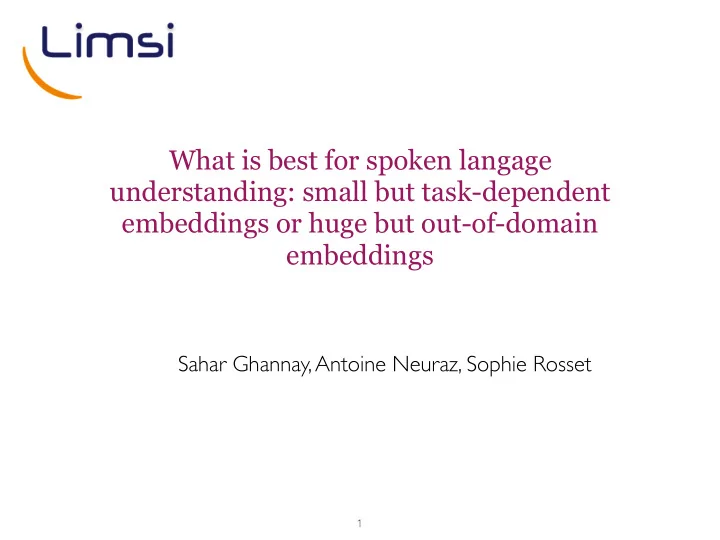

What is best for spoken langage understanding: small but task-dependent embeddings or huge but out-of-domain embeddings Sahar Ghannay, Antoine Neuraz, Sophie Rosset � 1
Goal • Focus on semantic evaluation of common word embeddings approaches for spoken language understanding task - with the aim of building a fast, robust, efficient and simple SLU system. • Investigate the use of two different data sets to train the embeddings: small and task-dependent corpus or huge and out of domain corpus • evaluate different benchmark corpora ATIS, SNIPS, M2M, and MEDIA � 2
Natural/Spoken language understanding task - Produce a semantic analysis and an formalization of the user’s utterance - SLU is often divided into 3 sub-tasks: domain classification, intent classification, and slot-filling (concept detection) • Example Hyp je veux réserver une chambre Concept commande nombre objet Label commande-B commande-I commande-I nombre-B objet-B Valeur réservation 1 chambre � 3
Word Embeddings • Context independent embeddings : - Skip-gram, CBOW, GloVe, FastText • Contextual embeddings - ELMO � 4
Word Embeddings Context independent N-gram features of the word w(t) CBOW Skip-gram FastText [T. Mikolov et al. 2013] [T. Mikolov et al. 2013] [P . Bojanowski et al. 2017] GloVe [J. Pennington et al. 2014] - Calcul d’une matrice de co-occurence X - Factorisation de X pour obtenir les word embeddings � 5
Contextual Word Embeddings • Embeddings from Language Models: ELMo - Learn word embeddings through building bidirectional language models (biLMs) ‣ biLMs consist of forward and backward LMs � 6
Contextual Word Embeddings • ELMo can models: - Complex characteristics of word use (e.g., syntax and semantics) - How these uses vary across linguistic contexts (i.e., to model polysemy) • ELMo di ff er from previous word embeddings approaches: - Each token is assigned a representation � 7
Experiments : Data and Results Data: • ATIS: concerns flight information • MEDIA: hotel reservation and information • M2M: restaurant and movie ticket booking. • SNIPS : multi-domain dialogue corpus collected by the SNIPS company: 7 in-house tasks such as Weather information, restaurant booking, managing playlist, etc. • SNIPS70 : sub-part of the SNIPS corpus, in which the training set is limited to 70 queries per intent randomly chosen. Corpus ATIS MEDIA SNIPS SNIPS70 M2M vocab. 1117 2445 14354 4751 900 #tags 84 70 39 39 12 train size 4978 12908 13784 2100 8148 test size 893 3005 700 700 4800 � 8
Experiments : Data and Results Word embeddings training: • Studying the impact of the corpora used to train the embeddings: - small and task-dependent corpus - huge and out-of-domain corpus. ‣ ELMo: using pre-trained models � 9
Experiments : Data and Results SLU model • b-LSTM • Composed of 2 hidden layers • Fed with only word embeddings � 10
Experiments : Data and Results Quantitative evaluation: task-dependent Out-of-domain Bench. ELMo FastText GloVe Skip-gram CBOW ELMo FastText GloVe Skip-gram CBOW M2M 88.89 72.13 92.54 88.87 89.39 91.14 93.01 91.77 93.19 92.13 ATIS 94.38 85.72 92.95 90.84 91.87 94.93 95.52 95.35 95.62 95.77 SNIPS 78.68 76.35 87.40 82.10 83.94 90.29 94.85 93.90 94.43 94.05 SNIPS70 53.06 38.19 63.65 47.11 49.76 75.19 79.75 78.68 78.90 80.13 82.66 86.42 MEDIA 80.26 71.73 80.01 79.57 85.30 85.11 85.95 86.06 Tagging performance of different word embeddings trained on task-dependent corpus (ATIS, MEDIA, M2M, SNIPS or SNIPS70) and on huge and out of domain corpus (WIKI English or French) on all benchmark corpora in terms of F1 using conlleval scoring script (in %) • The embeddings trained on huge and out-of-domain corpus yields to better results than the ones trained on small and task-dependent corpus • context independent approaches outperform significantly the contextual embeddings when they are trained on out-of-domain corpus � 11
Experiments : Data and Results Qualitative evaluation: Skip-gram SNIPS70 WIKI � 12
Experiments : Data and Results Qualitative evaluation: ELMo MEDIA WIKI � 13
Experiments : Data and Results Computation time: • For training and test time, we observe that ELMo is the slowest one - we can avoid training time by using pre-trained models. • For MEDIA, ELMo achieves the best results followed by CBOW which is the fastest in terms of train and test time. • As for dialog system the SLU model has to be simple, robust, e ffi cient and fast, in this case CBOW is the adequate approach we can use � 14
Conclusions • Evaluation of di ff erent word embeddings approaches on SLU task • Embeddings trained on huge and out-of-domain corpus yields to better results than the ones trained on small and task-dependent corpus • Count-based approaches like GloVe are not impacted by the lack of data. - CBOW, Skip-gram and especially FastText need more data for training to be e ffi cient. • Context independent approaches outperform the contextual embeddings (ELMo) when they are trained on out-of-domain corpus • The obtained results are interesting, since the embeddings are not tuned during training and we are not using additional features, so those results can be easily improved. • ELMo is the slowest one in terms of train and and test time, and for downstream tasks ( e.g. dialog system), it is preferable to use the fastest embedding model that achieves good performance. � 15
Thank you ! � 16
Recommend
More recommend